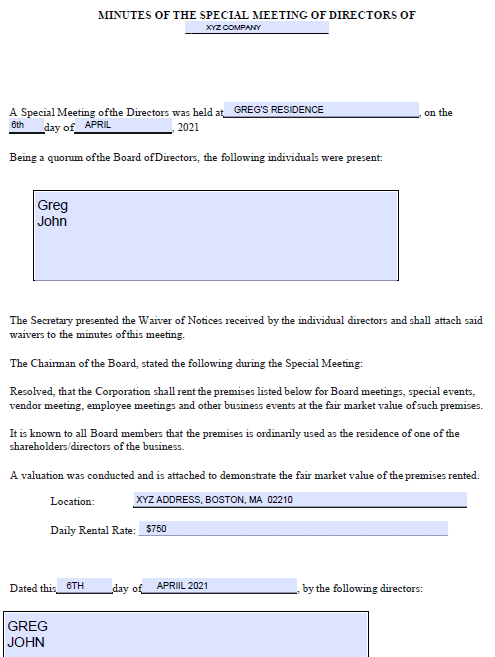Augusta Rule - Documenting
Now that we have given you the ins and outs of the Augusta Rule (IRS Section 280A(g)), it is important that this strategy is implemented properly. Anyone who wants to take advantage of this loophole in the tax code will need to make sure that there is documented justification for the rental fee, business approval, and verified business purposes for the home rental. Here, we go over what is necessary to ensure the IRS cannot disallow the benefits.
-
1Video
-
2Step 1 — Valuation WorksheetThe first step in documenting conformity with the Augusta Rule is to come up with fair market value (FVM) comparisons for other rental venues in the same geographic area where the business is located and document those comps using a valuation worksheet.
Purpose of Valuation
- A valuation worksheet is used to document the comparable rental venues that the company received quotes from in order to determine the fair market value of renting out the business owner's residence.
- Comparable venues need to be in the same geographic area as the residence to justify the FMV that is established for the rental of the residence.
- Large cities such as Boston might have multiple zip codes with varying economies, so comps should be in the same zip code.
- Recommended that the business get quotes from a minimum of three venues to come up with a justifiable rental FMV of the business owner's residence.
- Quotes are documented on the valuation worksheet in the company's records.
- If you live in an area where the rental market values fluctuate, it could be advantageous to strategically plan meetings during peak times to get even more tax-free income. NOTE: This would require getting additional quotes for those peak times as well.
Example: Using Boston as an example, XYZ Company is looking for comparable venues in the Boston area. NOTE: Three comps are recommended. To keep it simple, this example uses two comps.
- The first location quoted $700 per day for an executive suite and boardroom.

- A quote from a second location quoted $1,000 per day for a hotel conference room which offers food and is on a higher floor .

- The business owner/XYZ Company now has two documented comparable venue quotes showing what would it cost to rent out a meeting room for a day.
- Documented rental FMV is determined to be somewhere between $700 and $1,000 in the zip code where the residence is located.
- The business owner can now establish the rental fee of the residence to be within that $700-$1,000 range.
-
3Step 2 — Rental AgreementThe rental agreement is the second key piece of documentation that should be put in place to rent the business owner's residence when taking advantage of the Augusta Rule. The rental agreement keeps the transaction at arm's length and reflects the fair market value established for the rental.
A rental agreement should be prepared each time the residence is being used for business meeting purposes, up to 14 days. This not only provides the documentation for each meeting that occurred, but allows for changes in the rental price should market values fluctuate allowing the business owner to take advantage of those increases when they occur.Example: Greg owns a residence in Boston and he is renting this residence to his business, XYZ Company, for one day under the Augusta Rule. - A rental agreement is prepared and signed based on the FMV comps showing that the agreed upon rent is $750.
- That amount is due and payable on the day of the event from XYZ Company to Greg.
- Any other expenses incurred for the meeting would be reimbursed by the XYZ Company.
- This agreement is prepared & signed each time (up to 14 days) a business meeting for XYZ Company is held at Greg's home.

-
4Step 3 — Board of Directors ApprovalFor implementation purposes, the company officials or board of directors should formally adopt the rental of the business owner's home to the business for the daily rate established. This is a special meeting that only needs to happen one time to establish business approval of the rental. If fluctuations in the rental fee occur, additional special meetings would occur reflecting the adoption/approval of any updated fee associated with the rental of the business owner's residence.
- The board documents a waiver of announcement of the board meeting.
- The meeting is documented via special meeting minutes.
Example: The board of XYZ Company met in April at Greg's residence with John and another special advisor. - A waiver of announcement is prepared.
- Special meeting minutes document that the board has agreed to and approves the rental of Greg's residence and that evaluation was conducted setting the daily rental rate at $750.


-
5Step 4 — Meeting MinutesDocumentation of the events that occurred during the business meeting held at the business owner's residence are very important to prove that the meeting occurred and was a legitimate business expense. Someone attending the meeting should officially record the events of the meeting, including:
- Date and time of meeting
- Location of meeting
- Names of Attendees
- Purpose of the meeting
- Agenda and topics discussed
- Outcomes and Action Items resulting from the meeting
- Next meeting date and place (if applicable)
- Any documents that need to be recorded with the minutes of the meeting (if applicable)
-
6Step 5 — Invoice from the Business Owner to the CompanyFinally, the business owner should present the business with an invoice for the daily rate established. The invoice serves as documentation that there was a business purpose to the meeting and it was a fair market value transaction.
Did this answer your question?
If you still have a question, we’re here to help. Contact us

